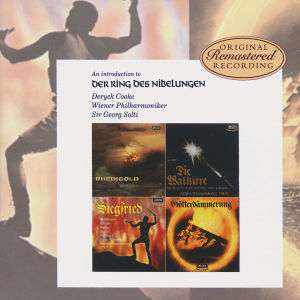Richard Wagner: Der Ring des Nibelungen - An Introduction
Der Ring des Nibelungen - An Introduction
Deryck Cooke, Birgit Nilsson, Hans Hotter, James King, Gottlob Frick, Brigitte Fassbaender, Lucia Popp, Christa Ludwig, Wiener Philharmoniker, Georg Solti
2
CDs
CD (Compact Disc)
Herkömmliche CD, die mit allen CD-Playern und Computerlaufwerken, aber auch mit den meisten SACD- oder Multiplayern abspielbar ist.
Derzeit nicht erhältlich.
Lassen Sie sich über unseren eCourier benachrichtigen, falls das Produkt bestellt werden kann.
Lassen Sie sich über unseren eCourier benachrichtigen, falls das Produkt bestellt werden kann.
- Eine Erläuterung und Analyse von Wagners leitmotivischen Bezügen von Deryck Cooke mit insgesamt 193 Musikbeispielen.
- Künstler: Sprecher: Deryck Cooke (in engl. Spr.),Birgit Nilsson, Hans Hotter, James King, Gottlob Frick, Brigitte Fassbaender, Lucia Popp, Christa Ludwig, Wiener Philharmoniker, Georg Solti
- Label: Decca, ADD, 1958-1963
- Erscheinungstermin: 9.3.2000
- Tracklisting
- Details
- Mitwirkende
Disk 1 von 2 (CD)
Der Ring des Nibelungen
- 1 1. Of all great musical compositions Ex.1-4 (An Introduction by Deryck Cooke with musical examples)
- 2 2. The fundamental symbol Ex.5-11 (An Introduction by Deryck Cooke with musical examples)
- 3 3. Returning now to the Nature Motive Ex.12-16 (An Introduction by Deryck Cooke with musical examples)
- 4 4. A number of further motives Ex.17-21 (An Introduction by Deryck Cooke with musical examples)
- 5 5. A second, much smaller family Ex.22-25 (An Introduction by Deryck Cooke with musical examples)
- 6 6. So much for nature Ex.26-38 (An Introduction by Deryck Cooke with musical examples)
- 7 7. The cause of the deterioration Ex.39-44 (An Introduction by Deryck Cooke with musical examples)
- 8 8. The other transformation Ex.45-48 (An Introduction by Deryck Cooke with musical examples)
- 9 9. Several other motives Ex.49-52 (An Introduction by Deryck Cooke with musical examples)
- 10 10. Two further motives Ex.41,53-61 (An Introduction by Deryck Cooke with musical examples)
- 11 11. Basic motive associated with the spear Ex.62/68 Ex.62/8Ex.62/8 (An Introduction by Deryck Cooke with musical)
- 12 12. Along another, more complex line Ex.69-72 (An Introduction by Deryck Cooke with musical examples)
- 13 13. In Act 2 of "Walküre" Ex.69,73-75 (An Introduction by Deryck Cooke with musical examples)
- 14 14. Returning now to Act 2 of "Walküre Ex.76-79 (An Introduction by Deryck Cooke with musical examples)
- 15 15. Love is another of the central symbols Ex.80-83 (An Introduction by Deryck Cooke with musical examples)
- 16 16. Later in the same scene Ex.84-87 (An Introduction by Deryck Cooke with musical examples)
- 17 17. Freia's motive has 2 independent segments Ex.88-91 (An Introduction by Deryck Cooke with musical examples)
- 18 18. The label "Flight" Ex.92 (An Introduction by Deryck Cooke with musical examples)
- 19 19. When Fasolt, in Scene 2 of "Rhinegold" Ex.93-8 (An Introduction by Deryck Cooke with musical examples)
- 20 20. A little later in this interlude Ex.99-103 (An Introduction by Deryck Cooke with musical examples)
Disk 2 von 2 (CD)
Der Ring des Nibelungen
- 1 21. The other new motive Ex.104-09 (An Introduction by Deryck Cooke with musical examples)
- 2 22. There are several independent love-motives Ex.110- (An Introduction by Deryck Cooke with musical examples)
- 3 23. The characters in whose lives Ex.115-120 (An Introduction by Deryck Cooke with musical examples)
- 4 24. One further motive belongs Ex.121 (An Introduction by Deryck Cooke with musical examples)
- 5 25. The sword motive recurs Ex.122-130 (An Introduction by Deryck Cooke with musical examples)
- 6 26. Ironically, this phrase Ex.131-5 (An Introduction by Deryck Cooke with musical examples)
- 7 27. Closely associated with Gutrune's motive Ex.136-40 (An Introduction by Deryck Cooke with musical examples)
- 8 28. Here we come to the end Ex.141-6 (An Introduction by Deryck Cooke with musical examples)
- 9 29. Complementary to this symbol Ex.147-9 (An Introduction by Deryck Cooke with musical examples)
- 10 30. One last central symbol Ex.150-7 (An Introduction by Deryck Cooke with musical examples)
- 11 31. One further motive connected Ex.158-61 (An Introduction by Deryck Cooke with musical examples)
- 12 32. There are one or two motives Ex.162-8 (An Introduction by Deryck Cooke with musical examples)
- 13 33. These motives of Alberich & Mime Ex.169-71 (An Introduction by Deryck Cooke with musical examples)
- 14 34. Quite a number of subsidiary motives Ex.172-6 (An Introduction by Deryck Cooke with musical examples)
- 15 35. Besides this family of motives Ex.177-80 (An Introduction by Deryck Cooke with musical examples)
- 16 36. Our final example Ex.10,181-2 (An Introduction by Deryck Cooke with musical examples)
- 17 37. In the final scene of "Götterdämmerung" Ex.181-3 (An Introduction by Deryck Cooke with musical examples)
- 18 38. Even more masterly Ex.184-8 (An Introduction by Deryck Cooke with musical examples)
- 19 39. Now if we return Ex.189-91 (An Introduction by Deryck Cooke with musical examples)
- 20 40. This masterly way Ex.192-3 (An Introduction by Deryck Cooke with musical examples)
Mehr von Richard Wagner ...
 neu
neu
Richard Wagner
Parsifal (Deluxe-Ausgabe in 284-seitigem Hardcover-Booklet)
EUR 39,99**
4 CDs
EUR 34,99*

Richard Wagner
Die Walküre
EUR 23,99**
4 CDs
EUR 7,99*

Richard Wagner
Klaviertranskriptionen
EUR 19,99**
CD
EUR 17,99*

William Steinberg - Complete Command Classics Recordings
17 CDs
EUR 54,99*

Michael Spyres - BariTenor
EUR 19,99**
CD
EUR 9,99*

